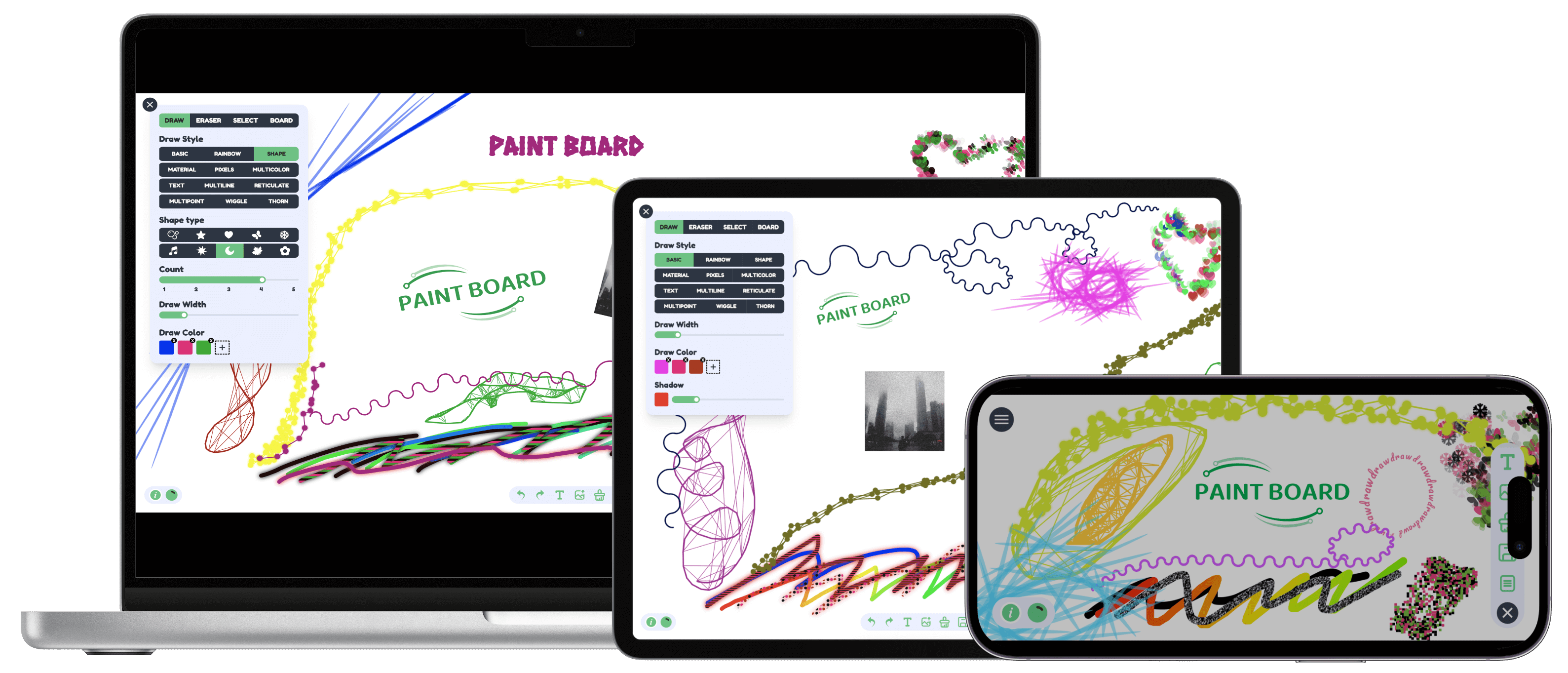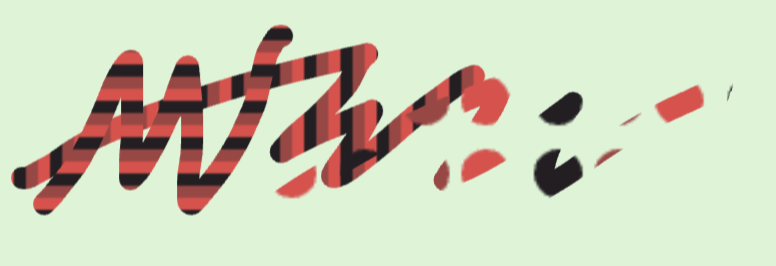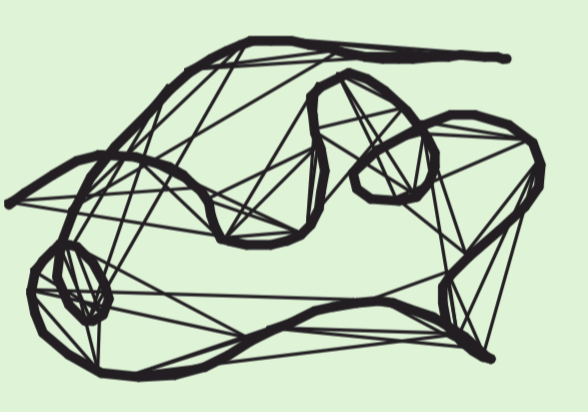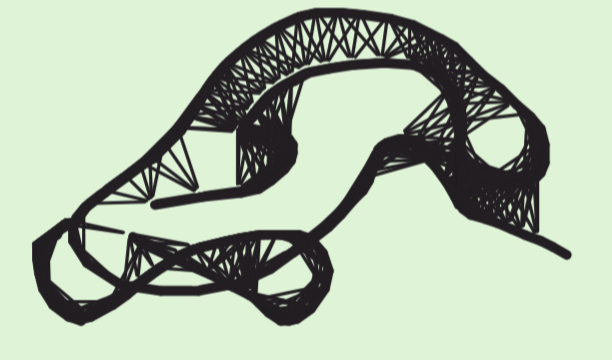Exploring the Canvas Series: Creative Brushes Part 2 (original) (raw)
Introduction
I am currently developing a powerful open source creative drawing board. This drawing board contains a variety of creative brushes, which allows users to experience a new drawing effect. Whether on mobile or PC , you can enjoy a better interactive experience and effect display . And this project has many powerful auxiliary painting functions, including but not limited to forward and backward, copy and delete, upload and download, multiple boards and layers and so on. I’m not going to list all the detailed features, looking forward to your exploration.
Link: https://songlh.top/paint-board/
Github: https://github.com/LHRUN/paint-board Welcome to Star ⭐️

In the gradual development of the project, I plan to write some articles, on the one hand, to record the technical details, which is my habit all the time. On the other hand, I’d like to promote the project, and I hope to get your use and feedback, and of course, a Star would be my greatest support.
I’m going to explain the implementation of the Creative Brush in 3 articles, this is the second one, and I’ll upload all the source code to my Github.
Multi Colour Brush
- The multicolour brush effect is as follows

- Multi-colour brushes are similar to material brushes in that they receive a
CanvasPatternobject viastrokeStyle. - We can create a new
canvas, then draw the effect you want on thiscanvas, and finally create apatternfrom thiscanvasand assign it to thestrokeStyleto get a multicolour brush effect.
import { useEffect, useRef, useState, MouseEvent } from 'react'
import './index.css'
let isMouseDown = false
let movePoint: { x: number, y: number } | null = null
const COLOR_WIDTH = 5 // width of each colour
/**
* get multicolour brush pattern
* @param colors Colour array, colours to be painted
*/
const getPattern = async (colors: string[]) => {
const canvas = document.createElement('canvas')
const context = canvas.getContext('2d') as CanvasRenderingContext2D
renderRow(canvas, context, colors)
return context.createPattern(canvas, 'repeat')
}
/**
* row effect drawing
*/
const renderRow = (
canvas: HTMLCanvasElement,
context: CanvasRenderingContext2D,
colors: string[]
) => {
canvas.width = 20
canvas.height = colors.length * COLOR_WIDTH
colors.forEach((color, i) => {
context.fillStyle = color
context.fillRect(0, COLOR_WIDTH * i, 20, COLOR_WIDTH)
})
}
function PaintBoard() {
const canvasRef = useRef<HTMLCanvasElement | null>(null)
const [context2D, setContext2D] = useState<CanvasRenderingContext2D | null>(null)
useEffect(() => {
initDraw()
}, [canvasRef])
const initDraw = async () => {
if (canvasRef?.current) {
const context2D = canvasRef?.current.getContext('2d')
if (context2D) {
context2D.lineCap = 'round'
context2D.lineJoin = 'round'
context2D.lineWidth = 10
// Assigns a value to strokeStyle based on the generated pattern
const pattern = await getPattern(['blue', 'red', 'black'])
if (pattern) {
context2D.strokeStyle = pattern
}
setContext2D(context2D)
}
}
}
const onMouseDown = () => {
if (!canvasRef?.current || !context2D) {
return
}
isMouseDown = true
}
const onMouseMove = (event: MouseEvent) => {
if (!canvasRef?.current || !context2D) {
return
}
if (isMouseDown) {
const { clientX, clientY } = event
if (movePoint) {
context2D.beginPath()
context2D.moveTo(movePoint.x, movePoint.y)
context2D.lineTo(clientX, clientY)
context2D.stroke()
}
movePoint = {
x: clientX,
y: clientY
}
}
}
const onMouseUp = () => {
if (!canvasRef?.current || !context2D) {
return
}
isMouseDown = false
movePoint = null
}
return (
<div>
<canvas
ref={canvasRef}
onMouseDown={onMouseDown}
onMouseMove={onMouseMove}
onMouseUp={onMouseUp}
/>
</div>
)
}Text Brush
- The text brush will follow the mouse movement to draw the text, the effect is as follows

- The text brush is drawn in three steps:
- The distance between the two moves is the distance, then the width of the text is determined by
measureText, if the distance is greater than the width of the text, then it can be drawn.
- The distance between the two moves is the distance, then the width of the text is determined by
- Then we take the vector of the two points, get the angle according to
Math.atan2, and draw the current text according to this angle.
- Then we take the vector of the two points, get the angle according to
- Finally, update the track coordinates, while drawing the text coordinates to the next one, and start again if the drawing is finished.
interface Point {
x: number
y: number
}
let isMouseDown = false
let movePoint: Point = { x: 0, y: 0 }
let counter = 0 // currently drawing text
const textValue = 'PaintBoard' // Drawing text content
const minFontSize = 5 // min fontsize
/**
* Get the distance between two points
*/
const getDistance = (start: Point, end: Point) => {
return Math.sqrt(Math.pow(start.x - end.x, 2) + Math.pow(start.y - end.y, 2))
}
function PaintBoard() {
const canvasRef = useRef<HTMLCanvasElement | null>(null)
const [context2D, setContext2D] = useState<CanvasRenderingContext2D | null>(null)
useEffect(() => {
if (canvasRef?.current) {
const context2D = canvasRef?.current.getContext('2d')
if (context2D) {
context2D.fillStyle = '#000'
setContext2D(context2D)
}
}
}, [canvasRef])
const onMouseDown = (event: MouseEvent) => {
if (!canvasRef?.current || !context2D) {
return
}
isMouseDown = true
const { clientX, clientY } = event
movePoint = {
x: clientX,
y: clientY
}
}
const onMouseMove = (event: MouseEvent) => {
if (!canvasRef?.current || !context2D) {
return
}
if (isMouseDown) {
const { clientX, clientY } = event
// Get the distance between two points
const distance = getDistance(movePoint, { x: clientX, y: clientY })
const fontSize = minFontSize + distance
const letter = textValue[counter]
context2D.font = `${fontSize}px Georgia`
// Get text width
const textWidth = context2D.measureText(letter).width
if (distance > textWidth) {
// Calculate the current movement angle
const angle = Math.atan2(clientY - movePoint.y, clientX - movePoint.x)
context2D.save();
context2D.translate(movePoint.x, movePoint.y)
context2D.rotate(angle);
context2D.fillText(letter, 0, 0);
context2D.restore();
// Update the position of the text after drawing
movePoint = {
x: movePoint.x + Math.cos(angle) * textWidth,
y: movePoint.y + Math.sin(angle) * textWidth
}
// Update data
counter++
if (counter > textValue.length - 1) {
counter = 0
}
}
}
}
const onMouseUp = () => {
if (!canvasRef?.current || !context2D) {
return
}
isMouseDown = false
movePoint = { x: 0, y: 0 }
}
return (
<div>
<canvas
ref={canvasRef}
onMouseDown={onMouseDown}
onMouseMove={onMouseMove}
onMouseUp={onMouseUp}
/>
</div>
)
}Multi Line Connection
- The effect of multi-line connection is as follows:

- Multiline connectivity is the process of connecting previous trajectory points twice during normal plotting, and then adjusting the number of points or the number of points to be connected to achieve different effects.
interface Point {
x: number
y: number
}
let isMouseDown = false
let movePoints: Point[] = [] // Mouse movement track point recording
function PaintBoard() {
const canvasRef = useRef<HTMLCanvasElement | null>(null)
const [context2D, setContext2D] = useState<CanvasRenderingContext2D | null>(null)
useEffect(() => {
if (canvasRef?.current) {
const context2D = canvasRef?.current.getContext('2d')
if (context2D) {
context2D.lineCap = 'round'
context2D.lineJoin = 'round'
context2D.lineWidth = 3
setContext2D(context2D)
}
}
}, [canvasRef])
const onMouseDown = () => {
if (!canvasRef?.current || !context2D) {
return
}
isMouseDown = true
}
const onMouseMove = (event: MouseEvent) => {
if (!canvasRef?.current || !context2D) {
return
}
if (isMouseDown) {
const { clientX, clientY } = event
const length = movePoints.length
if (length) {
// Normal line segment connection
context2D.beginPath()
context2D.moveTo(movePoints[length - 1].x, movePoints[length - 1].y)
context2D.lineTo(clientX, clientY)
context2D.stroke()
/**
* Linking of previous mouse points
* Currently, connections are made at intervals of 5 points, and the number of connections is 3.
*/
if (length % 5 === 0) {
for (
let i = movePoints.length - 5, count = 0;
i >= 0 && count < 3;
i = i - 5, count++
) {
context2D.save()
context2D.beginPath()
context2D.lineWidth = 1
context2D.moveTo(movePoints[length - 1].x, movePoints[length - 1].y)
context2D.lineTo(movePoints[i].x, movePoints[i].y)
context2D.stroke()
context2D.restore()
}
}
}
movePoints.push({
x: clientX,
y: clientY
})
}
}
const onMouseUp = () => {
if (!canvasRef?.current || !context2D) {
return
}
isMouseDown = false
movePoints = []
}
return (
<div>
<canvas
ref={canvasRef}
onMouseDown={onMouseDown}
onMouseMove={onMouseMove}
onMouseUp={onMouseUp}
/>
</div>
)
}Reticulate Brush
- The reticulate brush effect is as follows

- Reticulate brush is in the normal drawing process, will be traversed on the previous track points, if certain conditions are met, it will be judged as similar, and then the similar points for the second connection, multiple connections will achieve the effect of the net!
interface Point {
x: number
y: number
}
let isMouseDown = false
let movePoints: Point[] = [] // Mouse point recording
function PaintBoard() {
const canvasRef = useRef<HTMLCanvasElement | null>(null)
const [context2D, setContext2D] = useState<CanvasRenderingContext2D | null>(null)
useEffect(() => {
if (canvasRef?.current) {
const context2D = canvasRef?.current.getContext('2d')
if (context2D) {
context2D.lineCap = 'round'
context2D.lineJoin = 'round'
context2D.lineWidth = 3
setContext2D(context2D)
}
}
}, [canvasRef])
const onMouseDown = () => {
if (!canvasRef?.current || !context2D) {
return
}
isMouseDown = true
}
const onMouseMove = (event: MouseEvent) => {
if (!canvasRef?.current || !context2D) {
return
}
if (isMouseDown) {
const { clientX, clientY } = event
const length = movePoints.length
if (length) {
// Normal Drawing Connection
context2D.beginPath()
context2D.moveTo(movePoints[length - 1].x, movePoints[length - 1].y)
context2D.lineTo(clientX, clientY)
context2D.stroke()
if (length % 2 === 0) {
const limitDistance = 1000
/**
* If dx * dx + dy * dy < 1000, then the two points are considered to be close, and the line is quadratically connected.
* limitDistance can be adjusted by yourself
*/
for (let i = 0; i < length; i++) {
const dx = movePoints[i].x - movePoints[length - 1].x
const dy = movePoints[i].y - movePoints[length - 1].y
const d = dx * dx + dy * dy
if (d < limitDistance) {
context2D.save()
context2D.beginPath()
context2D.lineWidth = 1
context2D.moveTo(movePoints[length - 1].x, movePoints[length - 1].y)
context2D.lineTo(movePoints[i].x, movePoints[i].y)
context2D.stroke()
context2D.restore()
}
}
}
}
movePoints.push({
x: clientX,
y: clientY
})
}
}
const onMouseUp = () => {
if (!canvasRef?.current || !context2D) {
return
}
isMouseDown = false
movePoints = []
}
return (
<div>
<canvas
ref={canvasRef}
onMouseDown={onMouseDown}
onMouseMove={onMouseMove}
onMouseUp={onMouseUp}
/>
</div>
)
}Conclusion
Thank you for reading. This is the whole content of this article, I hope this article is helpful to you, welcome to like and favourite. If you have any questions, please feel free to discuss in the comment section!